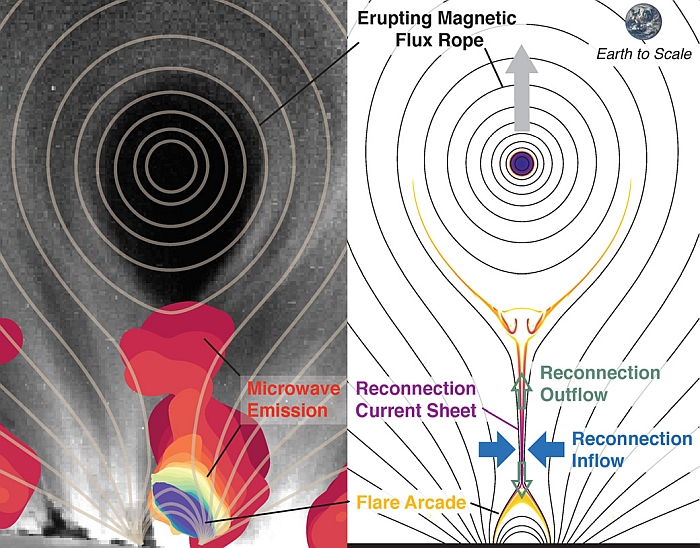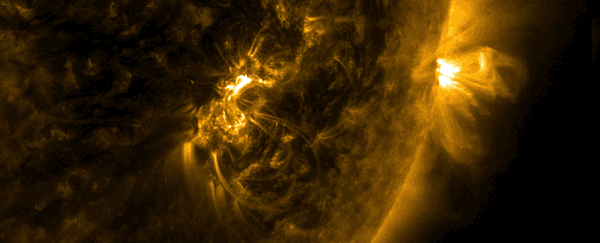The Sun is a wild place. Up in our skies, it appears pretty much the same day to day, but when you look closer, our star is often riotous with turbulent plasma.
One of the wildest things the Sun can do is flare - belch out colossal loops of plasma that utterly dwarf our entire Earth in scale. Although this activity is quite common, we still don't fully understand what drives it.
Now, for the first time, solar physicists have measured and characterised the magnetic field of the gargantuan current sheet - surface electric current - that stretches across the core flaring region, the central engine that powers the energy release of solar flares.
"It has long been suggested that the sudden release of magnetic energy through the reconnection current sheet is responsible for these major eruptions, yet there has been no measurement of its magnetic properties," said physicist Bin Chen of the New Jersey Institute of Technology.
"With this study, we've finally measured the details of the magnetic field of a current sheet for the first time, giving us a new understanding of the central engine of the Sun's solar flares."
The Sun's magnetic fields are extremely complicated and messy. Our star is a roiling, turbulent ball of incredibly hot plasma, a fluid made up of charged particles that interacts strongly with electromagnetic forces.
Because the Sun is a sphere, the equatorial surface rotates faster than the poles. This results in the solar magnetic field growing tangled, which in turn can produce very strong localised magnetic fields all over the Sun, opening up the sunspots from which flares emerge.
In these localised magnetic fields, the magnetic field lines can get messy. At the roots of solar flares, opposing magnetic field lines connect, snap, and reconnect. In addition, powerful current sheets stretch across these core solar flare regions.
We know that magnetic reconnection results in the release of energy and acceleration of electrons to relativistic speeds, but exactly how and where this occurred in the structure has been difficult to pin down.
Cue a colossal, X8.2 solar flare that took place on 10 September 2017. It was caught in multiple wavelengths by the New Jersey Institute of Technology's Expanded Owens Valley Solar Array (EOVSA), which allowed the team to study the 40,000-kilometre (25,000-mile) current sheet in close detail.
"The place where all the energy is stored and released in solar flares has been invisible until now … To play on a term from cosmology, it is the Sun's ' dark energy problem', and previously we've had to infer indirectly that the flare's magnetic reconnection sheet existed," said EOVSA director Dale Gary of the New Jersey Institute of Technology.
"EOVSA's images made at many microwave frequencies showed we can capture radio emissions to illuminate this important region."
 (NJIT-CSTR, B. Chen, S. Yu; CfA, C. Shen; Solar Dynamics Observatory)
(NJIT-CSTR, B. Chen, S. Yu; CfA, C. Shen; Solar Dynamics Observatory)
Above: Ultraviolet observations (left) and numerical simulation (right) of the flare.
The team combined their multi-wavelength data with numerical simulations conducted by physicists from the Harvard-Smithsonian Center for Astrophysics. Not only did the profile of the magnetic field along the current sheet match predictions, there was a magnetic, bottle-shaped structure at the top of the base of the flare - 20,000 kilometres (12,500 miles) from the Sun's surface - where electrons were being trapped and accelerated.
The sheet and magnetic reconnection both seem necessary for the energy release and electron acceleration. Magnetic energy is released into the current sheet at a rate of around 10-100 billion trillion joules per second, according to the team's calculations. But, surprisingly, that's not where particle acceleration takes place.
"Such an enormous energy release at the current sheet is mind-blowing. The strong electric field generated there can easily accelerate the electrons to relativistic energies, but the unexpected fact we found was that the electric field profile in the current sheet region did not coincide with the spatial distribution of relativistic electrons that we measured," said Chen.
"In other words, something else had to be at play to accelerate or redirect these electrons. What our data showed was a special location at the bottom of the current sheet - the magnetic bottle - appears to be crucial in producing or confining the relativistic electrons."
Although such structures have been proposed before, this is the first time they've been demonstrated, the researchers noted. And the new measurements can now be used as a baseline to study and analyse future solar flares, as well as further study into the electron acceleration mechanism therein.
The research has been published in Nature Astronomy.
